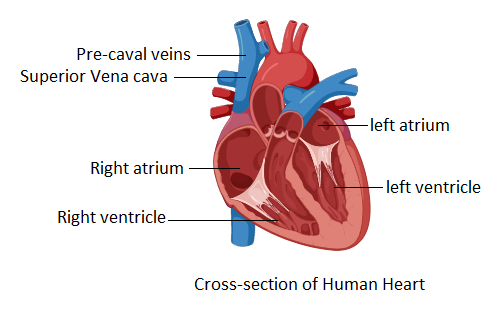
Answer
436.2k+ views
Hint: The superior vena cava, as its name suggests, it is the superior of the two venae cavae of the heart. These are great venous trunks that pour deoxygenated blood from the circulatory system to the right atrium of the heart. The pre-caval veins are situated before the venae cavae and collect the blood from the upper body for superior vena cava.
Complete answer: The circulatory system of the human is a complex system of various individual units working together. The venous trunks of the heart collect deoxygenated blood from the body. It pours unfiltered blood to the right atrium of the heart. It is made of two main venae cavae. One of them is the superior vena cava. It has a large diameter but a shorter length. Thus, for blood collection, various pre-caval veins are joined to it. These veins collect deoxygenated blood from the upper portion of the body. Each of the pre-caval veins is formed by a combination of external jugular, internal jugular, subclavian, and anterior intercostal veins. The deoxygenated blood from the head, tongue, and the muscles of the jaw are collected by external jugular veins. Blood from the muscles of the neck and the brain is collected by the internal jugular veins. Blood from shoulders and forelimbs is received by the subclavian vein and this is connected to the external jugular vein. The intercostal vein is connected to the right pre-caval. It collects blood from anterior intercostal spaces and an azygos vein. All of these bring blood from the posterior intercostal and the lumbar region.

Both of the left and right precaval veins pour blood into the right auricle of the heart. Thus, we can conclude that the superior vena cava of precaval veins collect blood from the head and forelimbs of the upper body.
So, the correct answer is option C.
Note: Damage to superior vena cava refers to the partial or complete obstruction of superior vena cava. Lung cancer, metastatic cancer, or lymphoma is related to superior vena cava obstruction. This can lead to enlarged veins in the head and neck that can cause breathlessness, cough, difficulty in swallowing, and chest pain. Chemotherapy and radiotherapy can be effective treatments.
Complete answer: The circulatory system of the human is a complex system of various individual units working together. The venous trunks of the heart collect deoxygenated blood from the body. It pours unfiltered blood to the right atrium of the heart. It is made of two main venae cavae. One of them is the superior vena cava. It has a large diameter but a shorter length. Thus, for blood collection, various pre-caval veins are joined to it. These veins collect deoxygenated blood from the upper portion of the body. Each of the pre-caval veins is formed by a combination of external jugular, internal jugular, subclavian, and anterior intercostal veins. The deoxygenated blood from the head, tongue, and the muscles of the jaw are collected by external jugular veins. Blood from the muscles of the neck and the brain is collected by the internal jugular veins. Blood from shoulders and forelimbs is received by the subclavian vein and this is connected to the external jugular vein. The intercostal vein is connected to the right pre-caval. It collects blood from anterior intercostal spaces and an azygos vein. All of these bring blood from the posterior intercostal and the lumbar region.

Both of the left and right precaval veins pour blood into the right auricle of the heart. Thus, we can conclude that the superior vena cava of precaval veins collect blood from the head and forelimbs of the upper body.
So, the correct answer is option C.
Note: Damage to superior vena cava refers to the partial or complete obstruction of superior vena cava. Lung cancer, metastatic cancer, or lymphoma is related to superior vena cava obstruction. This can lead to enlarged veins in the head and neck that can cause breathlessness, cough, difficulty in swallowing, and chest pain. Chemotherapy and radiotherapy can be effective treatments.
Recently Updated Pages
Who among the following was the religious guru of class 7 social science CBSE

what is the correct chronological order of the following class 10 social science CBSE

Which of the following was not the actual cause for class 10 social science CBSE

Which of the following statements is not correct A class 10 social science CBSE

Which of the following leaders was not present in the class 10 social science CBSE

Garampani Sanctuary is located at A Diphu Assam B Gangtok class 10 social science CBSE

Trending doubts
A rainbow has circular shape because A The earth is class 11 physics CBSE

Which are the Top 10 Largest Countries of the World?

Fill the blanks with the suitable prepositions 1 The class 9 english CBSE

Which of the following was the capital of the Surasena class 6 social science CBSE

How do you graph the function fx 4x class 9 maths CBSE

The Equation xxx + 2 is Satisfied when x is Equal to Class 10 Maths

Give 10 examples for herbs , shrubs , climbers , creepers

Difference between Prokaryotic cell and Eukaryotic class 11 biology CBSE

Who was the first Director General of the Archaeological class 10 social science CBSE




